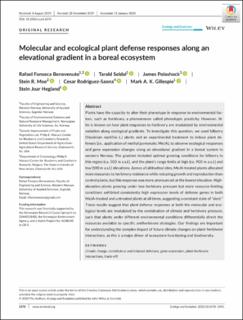| dc.contributor.author | Benevenuto, Rafael Fonseca | |
| dc.contributor.author | Seldal, Tarald | |
| dc.contributor.author | Polashock, James | |
| dc.contributor.author | Moe, Stein Ragnar | |
| dc.contributor.author | Rodriguez-Saona, Cesar | |
| dc.contributor.author | Gillespie, Mark Andrew Kusk | |
| dc.contributor.author | Hegland, Stein Joar | |
| dc.date.accessioned | 2020-04-22T12:36:41Z | |
| dc.date.available | 2020-04-22T12:36:41Z | |
| dc.date.created | 2020-01-29T10:44:26Z | |
| dc.date.issued | 2020 | |
| dc.identifier.citation | Benevenuto, R. F., Seldal, T., Polashock, J., Moe, S. R., Rodriguez‐Saona, C., Gillespie, M. A. K. & Hegland, S. J. (2020). Molecular and ecological plant defense responses along an elevational gradient in a boreal ecosystem. Ecology and Evolution, 10(5), 2478-2491. | en_US |
| dc.identifier.issn | 2045-7758 | |
| dc.identifier.uri | https://hdl.handle.net/11250/2652108 | |
| dc.description.abstract | Plants have the capacity to alter their phenotype in response to environmental factors, such as herbivory, a phenomenon called phenotypic plasticity. However, little is known on how plant responses to herbivory are modulated by environmental variation along ecological gradients. To investigate this question, we used bilberry (Vaccinium myrtillus L.) plants and an experimental treatment to induce plant defenses (i.e., application of methyl jasmonate; MeJA), to observe ecological responses and gene expression changes along an elevational gradient in a boreal system in western Norway. The gradient included optimal growing conditions for bilberry in this region (ca. 500 m a.s.l.), and the plant's range limits at high (ca. 900 m a.s.l.) and low (100 m a.s.l.) elevations. Across all altitudinal sites, MeJA‐treated plants allocated more resources to herbivory resistance while reducing growth and reproduction than control plants, but this response was more pronounced at the lowest elevation. High‐elevation plants growing under less herbivory pressure but more resource‐limiting conditions exhibited consistently high expression levels of defense genes in both MeJA‐treated and untreated plants at all times, suggesting a constant state of “alert.” These results suggest that plant defense responses at both the molecular and ecological levels are modulated by the combination of climate and herbivory pressure, such that plants under different environmental conditions differentially direct the resources available to specific antiherbivore strategies. Our findings are important for understanding the complex impact of future climate changes on plant–herbivore interactions, as this is a major driver of ecosystem functioning and biodiversity. | en_US |
| dc.language.iso | eng | en_US |
| dc.rights | Navngivelse 4.0 Internasjonal | * |
| dc.rights.uri | http://creativecommons.org/licenses/by/4.0/deed.no | * |
| dc.subject | climate change | en_US |
| dc.subject | constitutive and induced defenses | en_US |
| dc.subject | gene expression | en_US |
| dc.subject | plant-herbivore interactions | en_US |
| dc.subject | trade-off | en_US |
| dc.title | Molecular and ecological plant defense responses along an elevational gradient in a boreal ecosystem | en_US |
| dc.type | Peer reviewed | en_US |
| dc.type | Journal article | en_US |
| dc.description.version | publishedVersion | en_US |
| dc.rights.holder | © 2020 The Authors. | en_US |
| dc.subject.nsi | VDP::Matematikk og Naturvitenskap: 400::Zoologiske og botaniske fag: 480::Økologi: 488 | en_US |
| dc.source.pagenumber | 2478-2491 | en_US |
| dc.source.volume | 10 | en_US |
| dc.source.journal | Ecology and Evolution | en_US |
| dc.source.issue | 5 | en_US |
| dc.identifier.doi | 10.1002/ece3.6074 | |
| dc.identifier.cristin | 1784979 | |
| dc.relation.project | Hatch Project: NJ08140 to CR-S | en_US |
| dc.relation.project | Norges forskningsråd: 204403 | en_US |
| cristin.ispublished | false | |
| cristin.fulltext | original | |
| cristin.qualitycode | 1 | |

